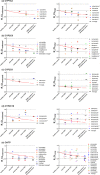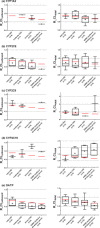Effect of Chronic Kidney Disease on Nonrenal Elimination Pathways: A Systematic Assessment of CYP1A2, CYP2C8, CYP2C9, CYP2C19, and OATP
- PMID: 28990182
- PMCID: PMC5947523
- DOI: 10.1002/cpt.807
Effect of Chronic Kidney Disease on Nonrenal Elimination Pathways: A Systematic Assessment of CYP1A2, CYP2C8, CYP2C9, CYP2C19, and OATP
Abstract
Our recent studies have shown that chronic kidney disease (CKD) affects the pharmacokinetics (PKs) of cytochrome P450 (CYP)2D6-metabolized drugs, whereas effects were less evident on CYP3A4/5. Therefore, the effect of CKD on the disposition of CYP1A2-metabolized, CYP2C8-metabolized, CYP2C9-metabolized, CYP2C19-metabolized, and organic anion-transporting polypeptide (OATP)-transported drugs was investigated. We identified dedicated CKD studies with 6, 5, 6, 4, and 12 "model" substrates for CYP1A2, CYP2C8, CYP2C9, CYP2C19, and OATP, respectively. Our analyses suggest that clearance of OATP substrates decreases as kidney function declines. Similar trends were seen for CYP2C8; but overlap between some CYP2C8 and OATP substrates highlights that their interplay needs further investigation. In contrast, the effect of CKD on CYP1A2, CYP2C9, and CYP2C19 was variable and modest compared to CYP2C8 and OATP. This improved understanding of elimination-pathway-dependency in CKD is important to inform the need and conduct of PK studies in these patients for nonrenally eliminated drugs.
Published 2017. This article is a U.S. Government work and is in the public domain in the USA. Clinical Pharmacology & Therapeutics published by Wiley Periodicals, Inc. on behalf of American Society for Clinical Pharmacology and Therapeutics.
Figures




Similar articles
-
Effect of eurycomanone on cytochrome P450 isoforms CYP1A2, CYP2A6, CYP2C8, CYP2C9, CYP2C19, CYP2E1 and CYP3A4 in vitro.J Nat Med. 2014 Apr;68(2):402-6. doi: 10.1007/s11418-013-0794-8. Epub 2013 Jul 24. J Nat Med. 2014. PMID: 23881640
-
Use of Physiologically Based Pharmacokinetic Modeling to Evaluate the Effect of Chronic Kidney Disease on the Disposition of Hepatic CYP2C8 and OATP1B Drug Substrates.Clin Pharmacol Ther. 2019 Mar;105(3):719-729. doi: 10.1002/cpt.1205. Epub 2018 Oct 26. Clin Pharmacol Ther. 2019. PMID: 30074626 Free PMC article.
-
Genetic Polymorphisms and in Vitro Functional Characterization of CYP2C8, CYP2C9, and CYP2C19 Allelic Variants.Biol Pharm Bull. 2016;39(11):1748-1759. doi: 10.1248/bpb.b16-00605. Biol Pharm Bull. 2016. PMID: 27803446 Review.
-
Evaluation of Herb-Drug Interaction of Synacinn™ and Individual Biomarker through Cytochrome 450 Inhibition Assay.Drug Metab Lett. 2018;12(1):62-67. doi: 10.2174/1872312812666180314112457. Drug Metab Lett. 2018. PMID: 29542427
-
Human Cytochrome P450 1, 2, 3 Families as Pharmacogenes with Emphases on Their Antimalarial and Antituberculosis Drugs and Prevalent African Alleles.Int J Mol Sci. 2023 Feb 8;24(4):3383. doi: 10.3390/ijms24043383. Int J Mol Sci. 2023. PMID: 36834793 Free PMC article. Review.
Cited by
-
PBPK Model of Coproporphyrin I: Evaluation of the Impact of SLCO1B1 Genotype, Ethnicity, and Sex on its Inter-Individual Variability.CPT Pharmacometrics Syst Pharmacol. 2021 Feb;10(2):137-147. doi: 10.1002/psp4.12582. Epub 2021 Jan 19. CPT Pharmacometrics Syst Pharmacol. 2021. PMID: 33289952 Free PMC article.
-
Current trends in drug metabolism and pharmacokinetics.Acta Pharm Sin B. 2019 Nov;9(6):1113-1144. doi: 10.1016/j.apsb.2019.10.001. Epub 2019 Oct 18. Acta Pharm Sin B. 2019. PMID: 31867160 Free PMC article. Review.
-
Sorafenib Population Pharmacokinetics and Skin Toxicities in Children and Adolescents with Refractory/Relapsed Leukemia or Solid Tumor Malignancies.Clin Cancer Res. 2019 Dec 15;25(24):7320-7330. doi: 10.1158/1078-0432.CCR-19-0470. Epub 2019 Aug 27. Clin Cancer Res. 2019. PMID: 31455680 Free PMC article.
-
Adverse events with co-prescription of angiotensin receptor blockers and clarithromycin compared to azithromycin: A population-based retrospective cohort study.Pharmacotherapy. 2025 Jul;45(7):414-425. doi: 10.1002/phar.70032. Epub 2025 Jul 17. Pharmacotherapy. 2025. PMID: 40671487 Free PMC article.
-
Novel Mechanistic PBPK Model to Predict Renal Clearance in Varying Stages of CKD by Incorporating Tubular Adaptation and Dynamic Passive Reabsorption.CPT Pharmacometrics Syst Pharmacol. 2020 Oct;9(10):571-583. doi: 10.1002/psp4.12553. Epub 2020 Sep 25. CPT Pharmacometrics Syst Pharmacol. 2020. PMID: 32977369 Free PMC article.
References
-
- Ladda, M.A. & Goralski, K.B. The effects of CKD on cytochrome P450‐mediated drug metabolism. Adv. Chronic Kidney Dis. 23, 67–75 (2016). - PubMed
-
- Jha, V. et al Chronic kidney disease: global dimension and perspectives. Lancet 382, 260–272 (2013). - PubMed
-
- Chen, Y.C. et al Risk factors associated with adverse drug events among older adults in emergency department. Eur. J. Intern. Med. 25, 49–55 (2014). - PubMed
-
- Nolin, T.D. , Naud, J. , Leblond, F.A. & Pichette, V. Emerging evidence of the impact of kidney disease on drug metabolism and transport. Clin. Pharmacol. Ther. 83, 898–903 (2008). - PubMed
Publication types
MeSH terms
Substances
Grants and funding
LinkOut - more resources
Full Text Sources
Other Literature Sources
Medical
Miscellaneous

